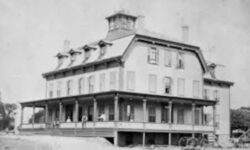by Audrey Anderson
Hometown Weekly Reporter
At the Walpole Public Library (WPL), wearing white bee suits with hoods and surrounded by sample bees, a wooden hive box, and other beekeeping paraphernalia, beekeeper Janice Barczys and her children talked about their experiences with bees. They also happily answered questions about bees and beekeeping from an eager audience of children and adults.
Barczys explained that she wanted to use natural skin care lotions and soaps that were healthy for her family. She decided to make her own. In researching how to do so, she found that many products that she could make included honey and beeswax. So, she decided to become a beekeeper and to get her family involved. She now offers soaps, beeswax wraps, diaper rash balm and other products on Saturdays at the Walpole Farmer’s Market.
Barczys said that early settlers brought honeybees and dandelions on their ships when sailing to America. Other types of bees are yellow jacket bees and bumblebees, but people harvest honey from honeybees alone.
Barczys then went on to give the audience some information about bees and their roles in the hive. A honeybee hive has one queen, 90% female worker bees, and 10% male drone bees. The queen stays in the hive and lays eggs in the cells of the hive. Fertilized eggs become female worker bees, and unfertilized become male drone bees.
Young female bees are nurse bees that create royal jelly to feed to newly born females and the queen. Then they become wax builders, guards, and foragers. As foragers, they go outside of the hive to collect pollen, traveling for 5 miles while using the sun as their guide. They map the area with the locations of flowers for collecting pollen. Female bees also sting to protect the hive. Once they sting one time, they die. Only the queen can sting multiple times.
Male bees are responsible for mating with queen bees. The drone congregation area is one mile high in the sky. This is where the queen bees mate with 15-20 drone bees, and only travel to the area to mate at one time in their lives. Queen bees never mate with drones from their own hives, keeping the genetic pool fresh.
In the winter, the bees maintain a temperature of 98 degrees in the hive. The queen bee is in the middle of female worker bees, who beat their wings to keep the queen warm. Most of the male drone bees are kicked out of the hive for the winter.
Barczys and her children demonstrated some of the real tools used in beekeeping, such as wooden hive boxes, a hive lifter, and a smoke pot. Attendees went up to the front table to see these unfamiliar items and ask questions about them.





















